Angus is one of the oldest and most famous cattle breeds in the world. There are unconfirmed accounts of doddies, a polled cattle type in the Angus region of Scotland, dating back nearly 500 years.
However, the Angus breed itself wasn’t developed from these doddies until the early 19th century. By the mid-1800s, the breed had gained significant traction, largely down to the committed work of Hugh Wastson, a man who would later be considered the father of the breed.
Establishment of herd books soon followed in Scotland, but a fire in 1851 destroyed the previous nine years of work before a number of principal breeders recommenced the collection of material in 1857.
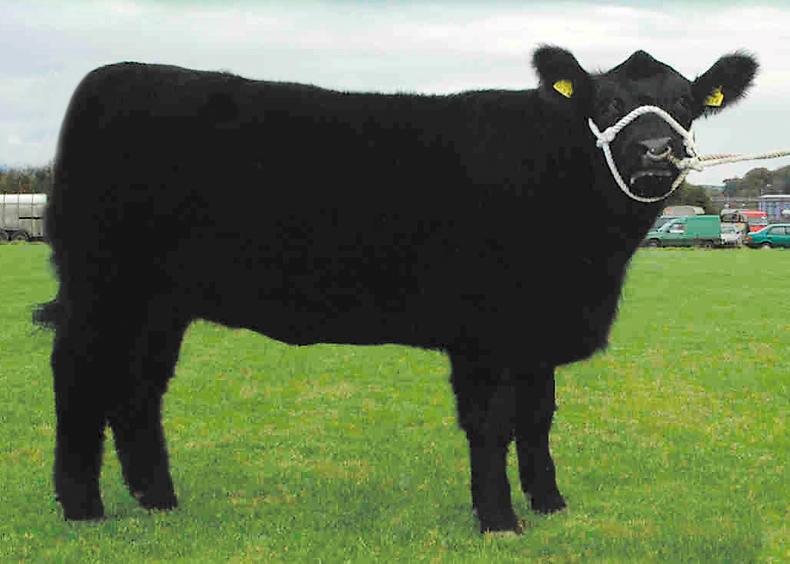
All-time record priced Angus in Ireland Lavalley Angie who sold for €31,000 in 2005.
This later led to the original herd book being released in April 1862, which contained 1,031 Aberdeen Angus entries.
While it is not known exactly when the breed originally came to Irish shores, it is believed it was pre-1840, as by the mid-1840s the breed was actively participating in agricultural shows here.
However, it wasn’t until 1894 that the Irish Aberdeen Angus Association was formed.
This association was set up to represent the interests of Irish breeders within the main society in Scotland.
Throughout the years, both in Ireland and the UK, the size of Angus cattle reduced and increased drastically.
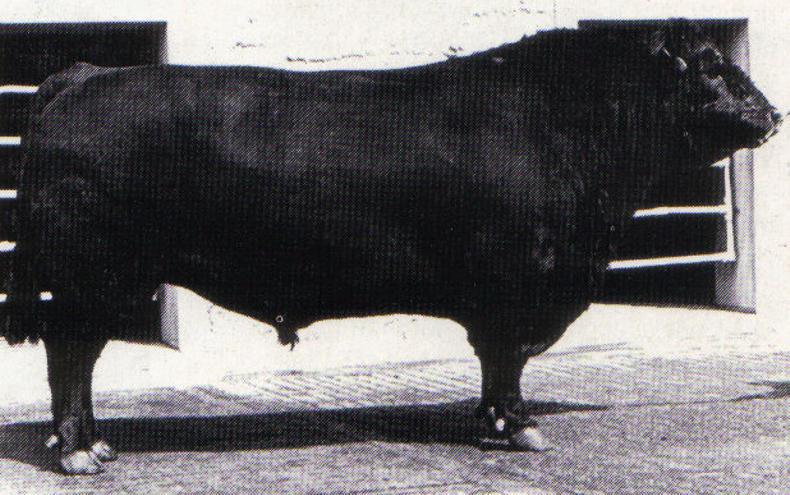
Imported sire Highland Colossal
The biggest change occurred around the mid-1900s when breeders bred smaller stock to achieve the top prices South American buyers were willing to pay at the Perth bull sales.
The highest price was in 1963 when a 13-month-old bull sold for 60,000gns, a record which still stands today. While this stood as a very lucrative market for sellers of the right bull, only 60 Angus, Shorthorn and Hereford bulls would sell to this market a year.
Breeders were becoming acutely aware by the 1960s that the breed was getting too small to produce a sufficient amount of meat and that the market was tightening.
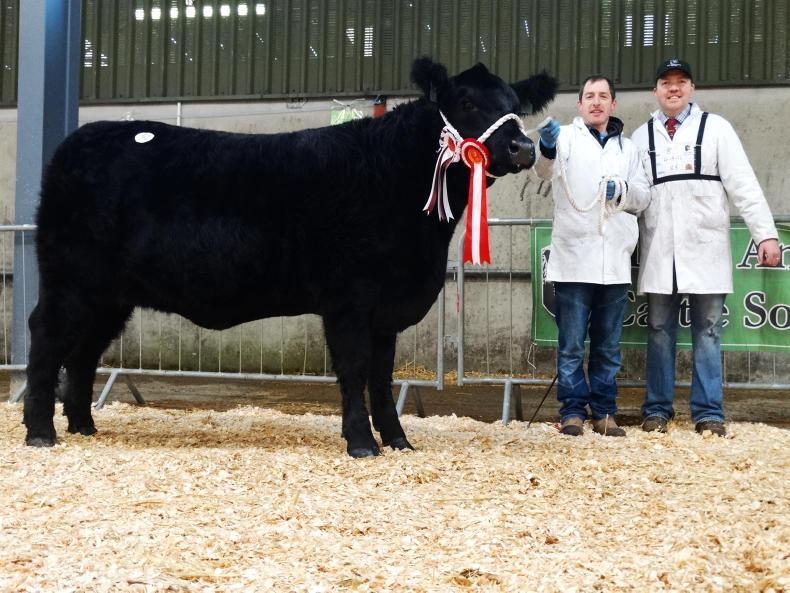
Carrigroe Mrs Dunbar who sold for €8,300 at last years Elite sale, pictured with Michael Dullea and breeder John Appelbe
This led breeders to look outside the UK, with the aim of reintroducing size into the Aberdeen Angus cattle of the time. However, society bylaws not only denied imported stock registration, but also any registration to any calves bred by artificvial insemination.
This position was due to the fears of the then much larger North American genetics replacing the in-demand smaller genetics available in Scotland.
Charolais importation 1964
Around the same time, the Charolais breed was introduced in Ireland. It had become apparent that Angus cattle could no longer supply the volumes of meat necessary for new export markets in the European Union.
This struck a chord with policymakers in the Department of Agriculture, who were aware that the Charolais breed was too big for areas of heavy land throughout Ireland.
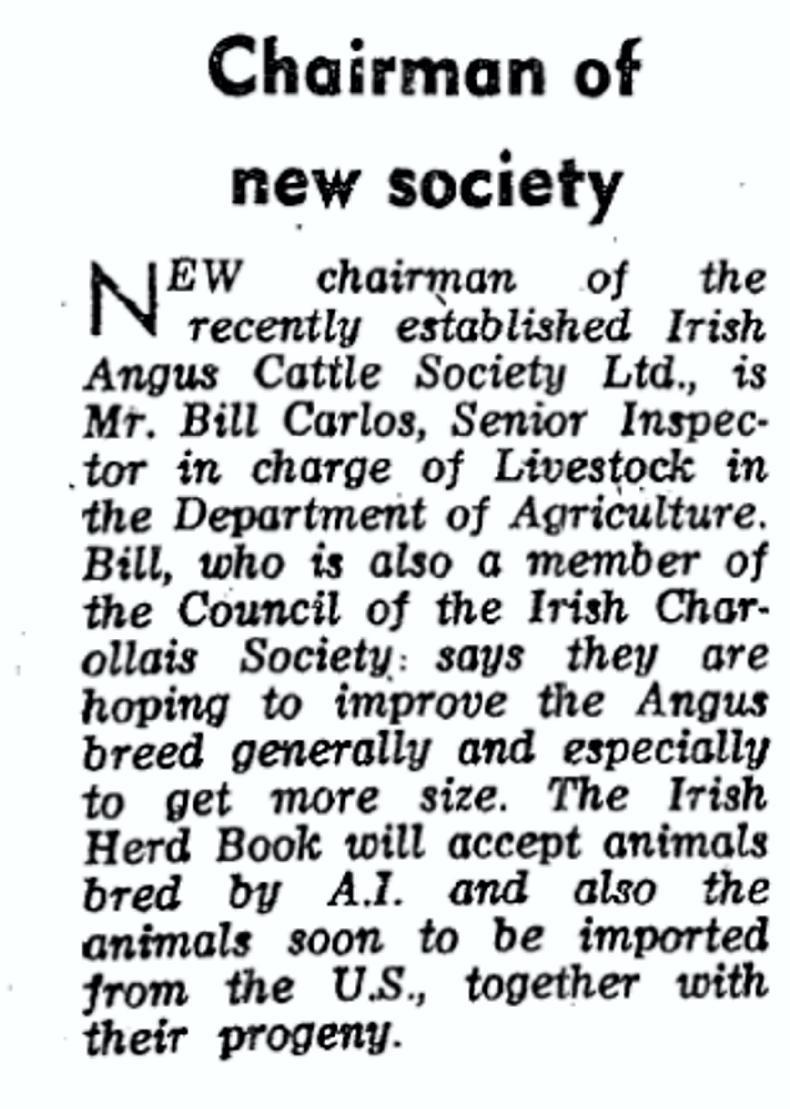
Irish Angus first chairman election in the Irish Farmers Journal on 13 May 1967
So the decision was made to look to North America to import larger-framed bulls to use on the Angus breed here in Ireland through AI.
This decision was not made lightly, with the Department aware of the stance the society took on the registering of imported and AI-bred animals.
Nonetheless, the Department decided to import with the mindset that if the society refused to register either the bulls or their progeny, then they would establish their own herd book.
Throughout 1966, Department officials, alongside Conor Carrigan, a Tipperary-based breeder familiar with Angus breeding, travelled throughout the US visiting herds and AI centres.
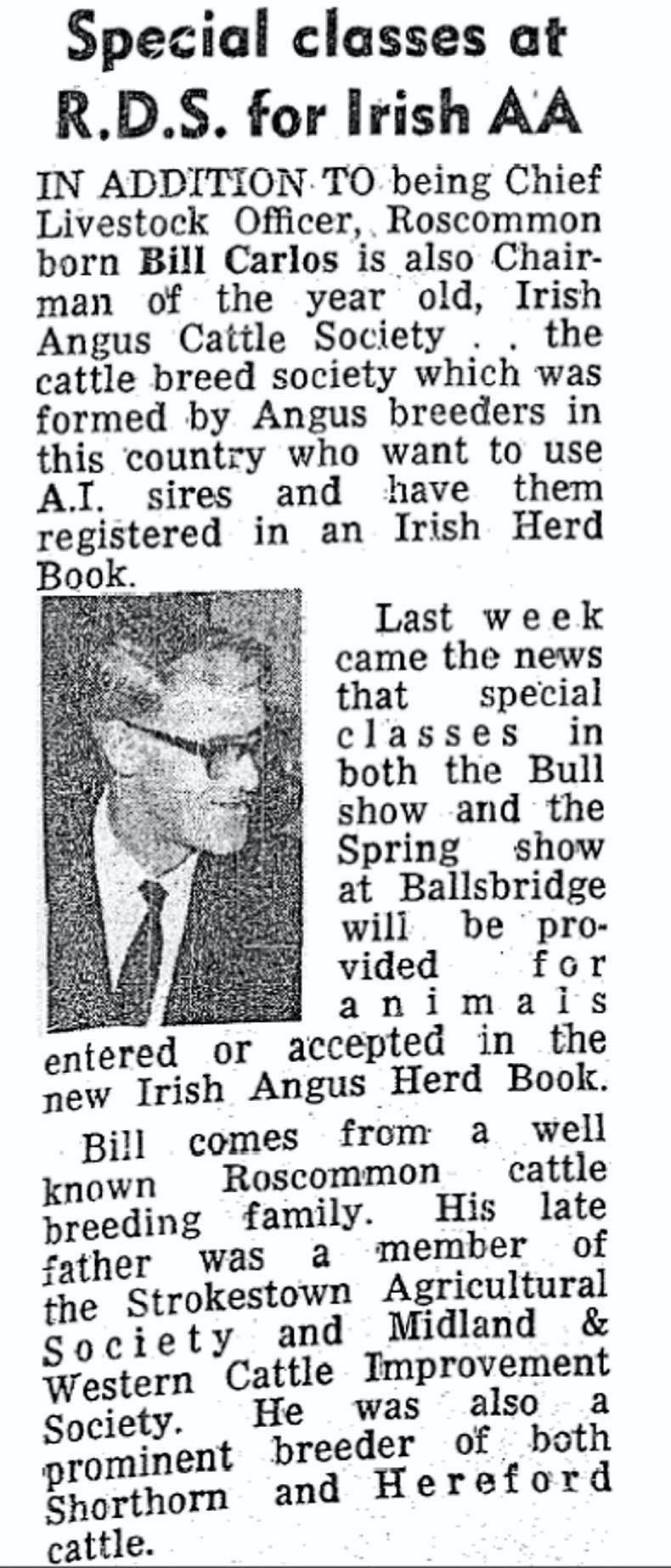
Irish Angus get own classes at the RDS, news piece which appeared in the Irish Farmers Journal 6 January 1968
In October of that year, the Department and Mr Carrigan purchased a number of stock at the Ankony herd dispersal.
On arrival back home, Mr Carrigan requested a hearing before the Aberdeen Angus council for a change to the society’s rules. The appeal was rejected by 20 votes to three.
History made
Soon after, the Irish Angus Cattle Society was founded with its own herd book. Department chief livestock inspector Bill Carlos became chair, Conor Carrigan vice-chair and Department inspector Barney Dunne secretary.
The first calf to be registered in the new Irish Angus herd book was born on 29 March 1967. Bred by Jimmy Caslin from Elphin, Co Roscommon, the heifer calf was called Creeve Josie and was sired by Emir of Haymount.
The Department continued its role as secretariat for a further 32 years until 1999, when the society took over complete responsibility and established an office in Carrick-on-Shannon.
Three years after the establishment of the Irish Angus Cattle Society, the Aberdeen Angus Cattle Society chief executive stepped down, which meant the entire council had to stand for re-election.
This led to a drastic shift in the demographic of the council and very quickly the prohibition on AI and live cattle importations was reversed.
While Canada was now the main port of call for larger genetics, Ireland’s cattle hadn’t become as small as the Scottish animal and were four years ahead on AI use, so Irish breeders also benefited from exports across the water.
Ireland was also looking to Canada as a source of further size in its stock. Two of the more notable early importations during the mid-1970s were Shannon Highland Colossal and Shannon Black Eagle Challenger.
Both carrying Shannon prefix as they arrived at Shannon Airport from Canada. They went to Sligo AI and Dovea AI and left their mark on the Angus breed, not just in Ireland but throughout the UK.
The success story
Since its establishment, the Irish Angus Cattle Society has had a lot of success. One of the most prominent success stories which continues to grow is that of the Irish Angus Producer Group.
The group began with two men, Joe Tighe and Roy Fossitt. Having begun conversations with Superquinn in the early 1990s, they started to supply certified Irish Angus beef in very small numbers to ABP Longford on a trial basis.
This didn’t initially work and in 1995 they tried a second time, having the cattle slaughtered in Kepak to supply Quinnsworth. They were joined at this stage by Seamus Caulfield, Michael Flanagan and Jim Foley, before Tim Dunne joined in 1996.
At this stage, they had managed to establish a reasonable demand of 50 to 60 cattle a week, all of which were sold to Quinnsworth in primal cut form and sold at their meat counters.
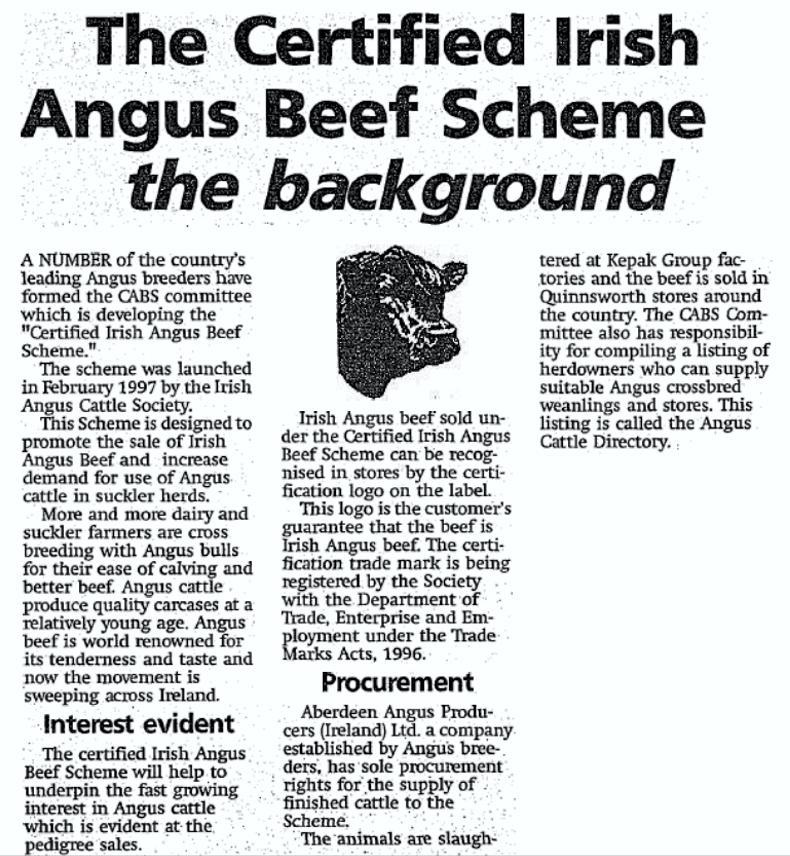
Irish Angus Producer Group advert which appeared in the Irish Farmers Journal in 8 November 1997
Then, in 1997, Tesco arrived in Ireland and it was from then on that the producer group really started to take off.
Charles Smith, current general manager, joined in 2000 and was met with a hard two years in the beef sector. Foot-and-mouth disease hit in 2001, followed by the BSE crisis of 2002.
However, following this, a huge emphasis was placed on quality and on better systems of verification and transparency. Tesco started to move towards retail packing, which Kepak performed on its behalf, while ABP also approached the group about certifying Angus cattle for them.
From then on, a partnership developed between the producer group and these two processors.
As the relationship further developed with Tesco, its support became the pillar of the group’s work.
Many European customers were developed, but nothing close to Tesco, in that the Europeans tended to take very select cuts, while Tesco took a range of cuts and greatly enhanced the carcase utilisation, allowing a recouping of the bonus paid to the farmer across a larger number of kilos of the animal.
In the beginning, the producer group had a mere 16 members. Today, this amounts to over 12,500, with 82,500 cattle slaughtered last year.
The group, along with its processing partners, also launched the Angus schools competition initiative in 2014.
This competition aims to educate students on farming and the beef sector as a whole.
Through its project-based system, students are awarded the chance to rear five calves.
This competition attracted less than 30 applicants in its first year, but has since grown to over 100. Not only has this strengthened the group in schools, it also helped reinforce the Angus brand throughout the country.
Sales
The biggest sale highlight for the society, and indeed Angus breeders in Ireland, was in 2005 when Lavalley Angie broke all records.
Having secured the junior championship at the all-Ireland finals in Strokestown the same year, the one-year-old Bohey Jasper daughter sold for a staggering €31,000, a record which still stands today.
She was bred by the Mullooly family from Strokestown and was bought by building contractor Malachy Hoare.
Last December, the society held its elite sale in Carrick-on-Shannon. Trade for females on the day was described as some of the best seen in many years. It saw heifers sell to average €3,400, up €300 on the year.
Topping the 2016 sale was John Appelbe’s Carrigroe Mrs Dunbar, who sold for €8,300 and now stands as the second-most expensive Irish Angus heifer at a sale.
The 2017 sale takes place on 9 December in Carrick-on-Shannon, with 77 bulls and 59 heifers going under the hammer.
Following the strong demand for both bulls and heifers over the last number of years, there has been a drastic increase in Angus calf registrations.
As of the end of 2016, Angus has overtaken the Limousin breed on pedigree registrations to secure number one spot.
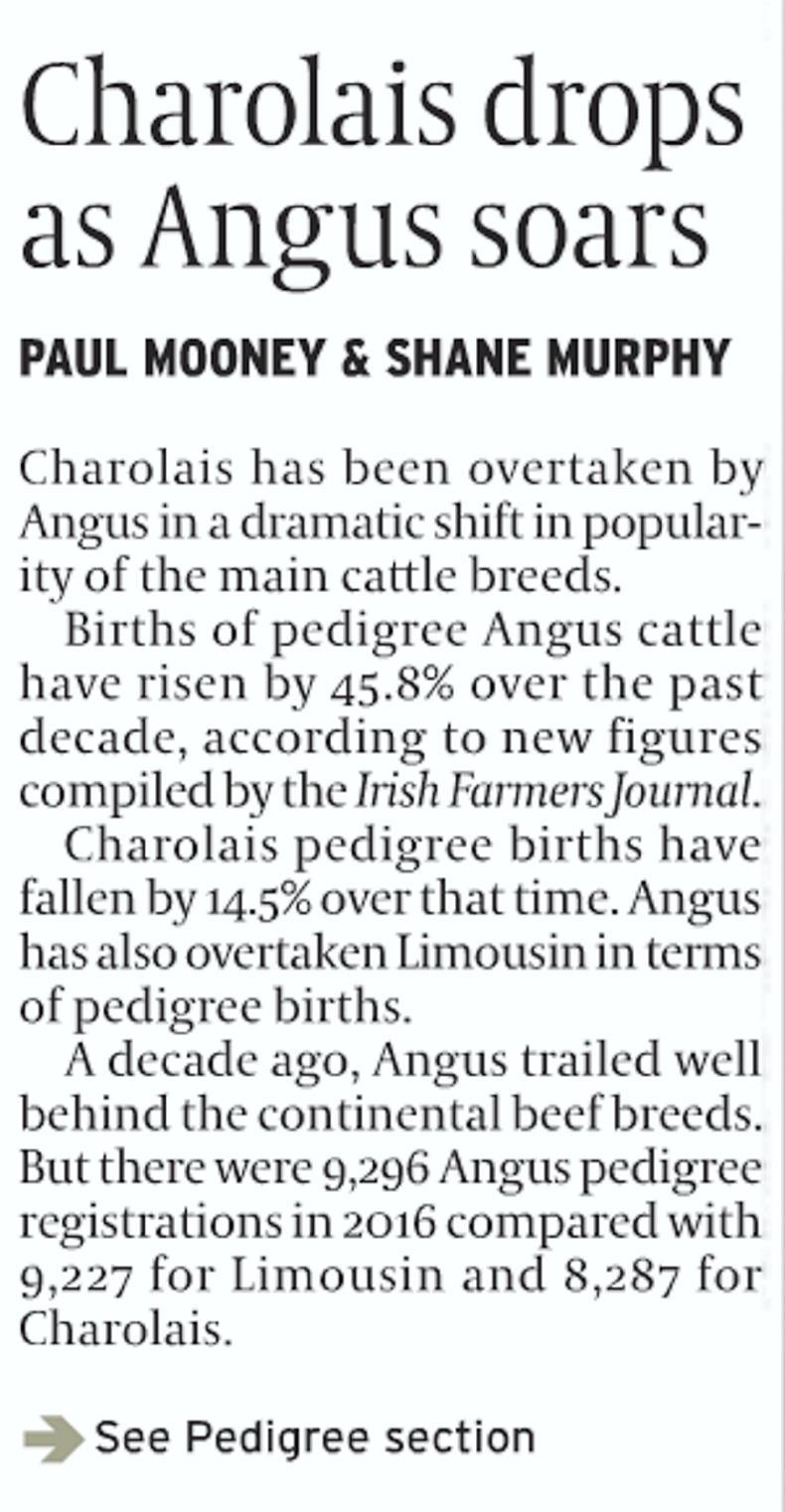
Front page news back in July about how Angus gain top spot for pedigree registrations in Ireland
Registrations for the Angus breed have increased by a massive 45% on 2011 levels to hit 9,296 registrations in 2016.
Pedigree registrations are not the only thing on the rise, with commercial Angus cattle also increasing. Last year saw the breed move up to second-most popular sire breed.
On suckler cows, over 100,000 calves were sired by an Angus bull, while in dairy cows, the breed took pole position, siring 246,138 beef calves.
There are a number of key reasons for this rise – the abolition of milk quota in 2015 has led to a noticeable increase in dairy cow numbers, which in turn has led to an increased demand for easier-calving, shorter-gestation bulls.
As previously mentioned, the reputation of the breed’s carcase qualities for marbling and taste has also grown massively in recent years.
Premium prices for in-spec cattle at factories means not only are dairy producers getting paid for the calf on the ground, but the Angus breed has also infiltrated a percentage of the suckler market.
Finally, export markets all around the EU for breeds such as Angus have flourished over the past number of years.
Exporters are continuing to seek out pedigree Angus heifers for buyers in countries such as Portugal, Russia, Kazakhstan and Romania to name a few.
The reputation Ireland carries from a quality and national herd health point of view is second to none.
This has led to stable prices for heifers for the past decade, in turn increasing the average price achieved by breeders year on year.
After 50 years, the Irish Angus Cattle Society now has 1,115 members, third-highest of any Irish cattle society, and registers 5,506 calves in its herd book.
Merger
While there is no doubting how far the society has come in just half a century, progress still needs to be made in joining the society with the Irish Aberdeen Angus Association.
A number of attempts have been made throughout the years, but with the breed stronger than ever, action needs to be taken.
Only when one organisation, with the sole objective of progressing the breed to its full potential is set up will the breed really reach the heights it has throughout the rest of the world.
Read more
ICBF stockbull finder off to a strong start
Pedigree calf fair bonanza
Galbally tops final Limousin sale
Angus is one of the oldest and most famous cattle breeds in the world. There are unconfirmed accounts of doddies, a polled cattle type in the Angus region of Scotland, dating back nearly 500 years.
However, the Angus breed itself wasn’t developed from these doddies until the early 19th century. By the mid-1800s, the breed had gained significant traction, largely down to the committed work of Hugh Wastson, a man who would later be considered the father of the breed.
Establishment of herd books soon followed in Scotland, but a fire in 1851 destroyed the previous nine years of work before a number of principal breeders recommenced the collection of material in 1857.

All-time record priced Angus in Ireland Lavalley Angie who sold for €31,000 in 2005.
This later led to the original herd book being released in April 1862, which contained 1,031 Aberdeen Angus entries.
While it is not known exactly when the breed originally came to Irish shores, it is believed it was pre-1840, as by the mid-1840s the breed was actively participating in agricultural shows here.
However, it wasn’t until 1894 that the Irish Aberdeen Angus Association was formed.
This association was set up to represent the interests of Irish breeders within the main society in Scotland.
Throughout the years, both in Ireland and the UK, the size of Angus cattle reduced and increased drastically.

Imported sire Highland Colossal
The biggest change occurred around the mid-1900s when breeders bred smaller stock to achieve the top prices South American buyers were willing to pay at the Perth bull sales.
The highest price was in 1963 when a 13-month-old bull sold for 60,000gns, a record which still stands today. While this stood as a very lucrative market for sellers of the right bull, only 60 Angus, Shorthorn and Hereford bulls would sell to this market a year.
Breeders were becoming acutely aware by the 1960s that the breed was getting too small to produce a sufficient amount of meat and that the market was tightening.

Carrigroe Mrs Dunbar who sold for €8,300 at last years Elite sale, pictured with Michael Dullea and breeder John Appelbe
This led breeders to look outside the UK, with the aim of reintroducing size into the Aberdeen Angus cattle of the time. However, society bylaws not only denied imported stock registration, but also any registration to any calves bred by artificvial insemination.
This position was due to the fears of the then much larger North American genetics replacing the in-demand smaller genetics available in Scotland.
Charolais importation 1964
Around the same time, the Charolais breed was introduced in Ireland. It had become apparent that Angus cattle could no longer supply the volumes of meat necessary for new export markets in the European Union.
This struck a chord with policymakers in the Department of Agriculture, who were aware that the Charolais breed was too big for areas of heavy land throughout Ireland.

Irish Angus first chairman election in the Irish Farmers Journal on 13 May 1967
So the decision was made to look to North America to import larger-framed bulls to use on the Angus breed here in Ireland through AI.
This decision was not made lightly, with the Department aware of the stance the society took on the registering of imported and AI-bred animals.
Nonetheless, the Department decided to import with the mindset that if the society refused to register either the bulls or their progeny, then they would establish their own herd book.
Throughout 1966, Department officials, alongside Conor Carrigan, a Tipperary-based breeder familiar with Angus breeding, travelled throughout the US visiting herds and AI centres.

Irish Angus get own classes at the RDS, news piece which appeared in the Irish Farmers Journal 6 January 1968
In October of that year, the Department and Mr Carrigan purchased a number of stock at the Ankony herd dispersal.
On arrival back home, Mr Carrigan requested a hearing before the Aberdeen Angus council for a change to the society’s rules. The appeal was rejected by 20 votes to three.
History made
Soon after, the Irish Angus Cattle Society was founded with its own herd book. Department chief livestock inspector Bill Carlos became chair, Conor Carrigan vice-chair and Department inspector Barney Dunne secretary.
The first calf to be registered in the new Irish Angus herd book was born on 29 March 1967. Bred by Jimmy Caslin from Elphin, Co Roscommon, the heifer calf was called Creeve Josie and was sired by Emir of Haymount.
The Department continued its role as secretariat for a further 32 years until 1999, when the society took over complete responsibility and established an office in Carrick-on-Shannon.
Three years after the establishment of the Irish Angus Cattle Society, the Aberdeen Angus Cattle Society chief executive stepped down, which meant the entire council had to stand for re-election.
This led to a drastic shift in the demographic of the council and very quickly the prohibition on AI and live cattle importations was reversed.
While Canada was now the main port of call for larger genetics, Ireland’s cattle hadn’t become as small as the Scottish animal and were four years ahead on AI use, so Irish breeders also benefited from exports across the water.
Ireland was also looking to Canada as a source of further size in its stock. Two of the more notable early importations during the mid-1970s were Shannon Highland Colossal and Shannon Black Eagle Challenger.
Both carrying Shannon prefix as they arrived at Shannon Airport from Canada. They went to Sligo AI and Dovea AI and left their mark on the Angus breed, not just in Ireland but throughout the UK.
The success story
Since its establishment, the Irish Angus Cattle Society has had a lot of success. One of the most prominent success stories which continues to grow is that of the Irish Angus Producer Group.
The group began with two men, Joe Tighe and Roy Fossitt. Having begun conversations with Superquinn in the early 1990s, they started to supply certified Irish Angus beef in very small numbers to ABP Longford on a trial basis.
This didn’t initially work and in 1995 they tried a second time, having the cattle slaughtered in Kepak to supply Quinnsworth. They were joined at this stage by Seamus Caulfield, Michael Flanagan and Jim Foley, before Tim Dunne joined in 1996.
At this stage, they had managed to establish a reasonable demand of 50 to 60 cattle a week, all of which were sold to Quinnsworth in primal cut form and sold at their meat counters.

Irish Angus Producer Group advert which appeared in the Irish Farmers Journal in 8 November 1997
Then, in 1997, Tesco arrived in Ireland and it was from then on that the producer group really started to take off.
Charles Smith, current general manager, joined in 2000 and was met with a hard two years in the beef sector. Foot-and-mouth disease hit in 2001, followed by the BSE crisis of 2002.
However, following this, a huge emphasis was placed on quality and on better systems of verification and transparency. Tesco started to move towards retail packing, which Kepak performed on its behalf, while ABP also approached the group about certifying Angus cattle for them.
From then on, a partnership developed between the producer group and these two processors.
As the relationship further developed with Tesco, its support became the pillar of the group’s work.
Many European customers were developed, but nothing close to Tesco, in that the Europeans tended to take very select cuts, while Tesco took a range of cuts and greatly enhanced the carcase utilisation, allowing a recouping of the bonus paid to the farmer across a larger number of kilos of the animal.
In the beginning, the producer group had a mere 16 members. Today, this amounts to over 12,500, with 82,500 cattle slaughtered last year.
The group, along with its processing partners, also launched the Angus schools competition initiative in 2014.
This competition aims to educate students on farming and the beef sector as a whole.
Through its project-based system, students are awarded the chance to rear five calves.
This competition attracted less than 30 applicants in its first year, but has since grown to over 100. Not only has this strengthened the group in schools, it also helped reinforce the Angus brand throughout the country.
Sales
The biggest sale highlight for the society, and indeed Angus breeders in Ireland, was in 2005 when Lavalley Angie broke all records.
Having secured the junior championship at the all-Ireland finals in Strokestown the same year, the one-year-old Bohey Jasper daughter sold for a staggering €31,000, a record which still stands today.
She was bred by the Mullooly family from Strokestown and was bought by building contractor Malachy Hoare.
Last December, the society held its elite sale in Carrick-on-Shannon. Trade for females on the day was described as some of the best seen in many years. It saw heifers sell to average €3,400, up €300 on the year.
Topping the 2016 sale was John Appelbe’s Carrigroe Mrs Dunbar, who sold for €8,300 and now stands as the second-most expensive Irish Angus heifer at a sale.
The 2017 sale takes place on 9 December in Carrick-on-Shannon, with 77 bulls and 59 heifers going under the hammer.
Following the strong demand for both bulls and heifers over the last number of years, there has been a drastic increase in Angus calf registrations.
As of the end of 2016, Angus has overtaken the Limousin breed on pedigree registrations to secure number one spot.

Front page news back in July about how Angus gain top spot for pedigree registrations in Ireland
Registrations for the Angus breed have increased by a massive 45% on 2011 levels to hit 9,296 registrations in 2016.
Pedigree registrations are not the only thing on the rise, with commercial Angus cattle also increasing. Last year saw the breed move up to second-most popular sire breed.
On suckler cows, over 100,000 calves were sired by an Angus bull, while in dairy cows, the breed took pole position, siring 246,138 beef calves.
There are a number of key reasons for this rise – the abolition of milk quota in 2015 has led to a noticeable increase in dairy cow numbers, which in turn has led to an increased demand for easier-calving, shorter-gestation bulls.
As previously mentioned, the reputation of the breed’s carcase qualities for marbling and taste has also grown massively in recent years.
Premium prices for in-spec cattle at factories means not only are dairy producers getting paid for the calf on the ground, but the Angus breed has also infiltrated a percentage of the suckler market.
Finally, export markets all around the EU for breeds such as Angus have flourished over the past number of years.
Exporters are continuing to seek out pedigree Angus heifers for buyers in countries such as Portugal, Russia, Kazakhstan and Romania to name a few.
The reputation Ireland carries from a quality and national herd health point of view is second to none.
This has led to stable prices for heifers for the past decade, in turn increasing the average price achieved by breeders year on year.
After 50 years, the Irish Angus Cattle Society now has 1,115 members, third-highest of any Irish cattle society, and registers 5,506 calves in its herd book.
Merger
While there is no doubting how far the society has come in just half a century, progress still needs to be made in joining the society with the Irish Aberdeen Angus Association.
A number of attempts have been made throughout the years, but with the breed stronger than ever, action needs to be taken.
Only when one organisation, with the sole objective of progressing the breed to its full potential is set up will the breed really reach the heights it has throughout the rest of the world.
Read more
ICBF stockbull finder off to a strong start
Pedigree calf fair bonanza
Galbally tops final Limousin sale












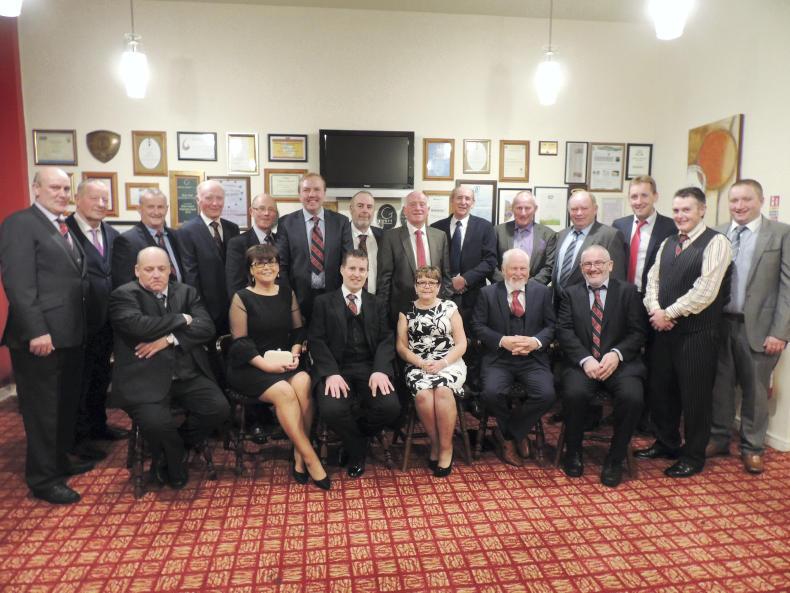
SHARING OPTIONS